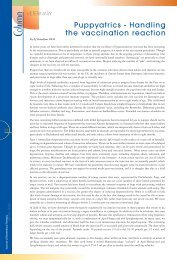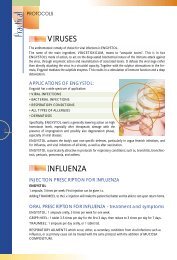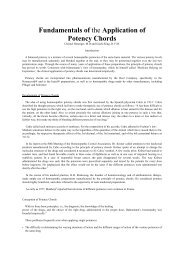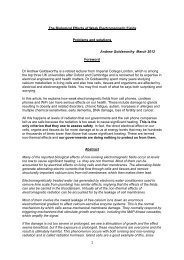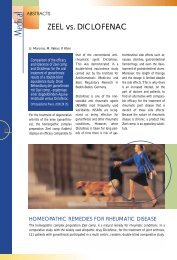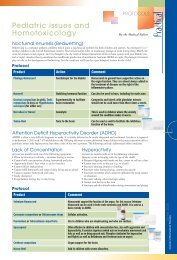4 - Management of Chronic Toxin Accumulation - Bio Pathica Ltd
4 - Management of Chronic Toxin Accumulation - Bio Pathica Ltd
4 - Management of Chronic Toxin Accumulation - Bio Pathica Ltd
Create successful ePaper yourself
Turn your PDF publications into a flip-book with our unique Google optimized e-Paper software.
) In Focus<br />
<strong>Management</strong> <strong>of</strong><br />
<strong>Chronic</strong> <strong>Toxin</strong> <strong>Accumulation</strong><br />
By Luigi Piroli, MD<br />
) 4<br />
Introduction<br />
Modern medicine is quite successful<br />
in diagnosing and treating acute intoxications<br />
as medical emergencies<br />
(heavy metal accumulation, drug<br />
poisoning, etc.) as well as various<br />
sub-acute, symptomatic toxicities<br />
(chemicals, drugs, and/or other xeno<br />
biotics), but only if laboratory<br />
evidence <strong>of</strong> intoxication is found. In<br />
recent years, however, the burden <strong>of</strong><br />
chronic toxin accumulation has become<br />
clearer and more disturbing as<br />
the effects <strong>of</strong> minute doses <strong>of</strong> toxins<br />
over time and effects on subsequent<br />
generations become evident. 1,2<br />
Individual tolerance <strong>of</strong> or susceptibility<br />
to specific toxins may vary. A<br />
biological system’s tolerance <strong>of</strong> a<br />
toxin is partly genetic and partly acquired<br />
on the basis <strong>of</strong> enzymatic induction<br />
and/or inhibitions, the degree<br />
<strong>of</strong> functionality <strong>of</strong> the target<br />
organ, and functional reserve capacity<br />
<strong>of</strong> specific organ systems. The<br />
clinical manifestations <strong>of</strong> biological<br />
effects <strong>of</strong> toxins depend not only on<br />
the physical and chemical properties<br />
<strong>of</strong> the toxin itself but also on the duration<br />
and route <strong>of</strong> exposure, the<br />
toxin’s mechanism <strong>of</strong> action, and<br />
(obviously) on individual susceptibility.<br />
Modern laboratories can now<br />
test for individual susceptibility.<br />
Chemical compounds, which comprise<br />
the bulk <strong>of</strong> environmental toxins,<br />
have spread throughout the<br />
world via the ground water, rain,<br />
and winds, and are now present even<br />
in areas where the chemicals were<br />
never used. <strong>Bio</strong>accumulation <strong>of</strong><br />
these compounds causes disease in<br />
living beings. In humans, the immune,<br />
endocrine, and neurological<br />
sys tems are the most affected. 3<br />
Xenobiotics and/or individual inability<br />
to deal with them seem to be<br />
at the root <strong>of</strong> many modern diseases,<br />
including Parkinson’s disease, chronic<br />
fatigue syndrome, and cancer. 4-6<br />
Managing chronic toxin<br />
accumulation<br />
As is clear from the above, in assessing<br />
a patient with toxicity, multiple<br />
factors need to be taken into account,<br />
including not only the total<br />
toxin load but also the individual<br />
patient’s response. Two patients exposed<br />
to the same amount <strong>of</strong> the<br />
same toxin may respond differently.<br />
Individual differences are apparent<br />
not only in how patients deal with<br />
toxins (primarily differences in metabolism<br />
or biotransformation) but<br />
also in how the toxins are stored<br />
and eliminated. Rather than assessing<br />
total exposure, therefore, it is<br />
more important to assess what each<br />
patient is doing with the toxin load.<br />
In homotoxicology, this is assessed<br />
indirectly on the Disease Evolution<br />
Table, where we measure the patient’s<br />
regulatory ability in terms <strong>of</strong><br />
disturbance in homeostasis. 7<br />
<strong>Bio</strong>transformation<br />
or metabolization <strong>of</strong> toxins<br />
Substances may undergo processes<br />
that make them water-soluble and<br />
thus more readily excreted, or they<br />
may undergo bioinactivation, which<br />
reduces the toxicity <strong>of</strong> the end product.<br />
<strong>Bio</strong>transformation takes place<br />
primarily in the liver and the intestinal<br />
tract and to a lesser extent in the<br />
skin, kidneys, and other organs.<br />
Phase I and II reactions<br />
These have been described elsewhere<br />
and will not be discussed in<br />
depth here. 8 Suffice it to say that<br />
phase I involves oxygenation; in<br />
pha se II, conjugation adds a watersoluble<br />
group to the reactive site<br />
formed in phase I. Thus detoxification<br />
is not a single process but a<br />
number <strong>of</strong> processes involved in<br />
the biotransfomation <strong>of</strong> xenobiotics.<br />
Eve ry step depends on several c<strong>of</strong>actors<br />
such as vitamins and minerals.<br />
Because phase I enzymes are<br />
mixed-function oxidases, a number<br />
<strong>of</strong> free radicals are formed during<br />
the detoxification process, so it is<br />
important to provide adequate nutritional<br />
and antioxidant support for<br />
the patient.<br />
Journal <strong>of</strong> <strong>Bio</strong>medical Therapy 2007 ) Vol. 1, No. 2
) In Focus<br />
Phase III –<br />
The antiporter system<br />
This system is active primarily in the<br />
intestines. Paradoxically, the intestinal<br />
mucosa functions both as a barrier<br />
and as a filter. As the first point<br />
<strong>of</strong> contact with drugs and food as<br />
well as environmental xenobiotics,<br />
the mucosa has developed a complex<br />
set <strong>of</strong> defense mechanisms, one<br />
<strong>of</strong> which is the so-called antiporter<br />
system. In this process, xenobiotics<br />
are actively pumped out <strong>of</strong> the cell<br />
to reduce their intracellular concentrations.<br />
This phenomenon was first<br />
observed in cancer cells, which<br />
actively eliminate chemotherapy<br />
agents. Antiporter activity in the intestinal<br />
wall seems to be co-regulated<br />
with the phase I CYP3A4 enzyme.<br />
9 It is therefore important to<br />
use products such as Mucosa compositum<br />
to support the intestinal<br />
wall during any detoxification and<br />
drainage treatment.<br />
Storage and elimination<br />
<strong>of</strong> toxins<br />
Release <strong>of</strong> toxins from their reservoirs<br />
depends on toxicokinetics (toxins<br />
are cleared “upstream” first, i.e.,<br />
out <strong>of</strong> the blood stream), on whether<br />
the reservoir is a rapid or slow exchange<br />
system, and on whether the<br />
chronobiology <strong>of</strong> the tissue (e.g., the<br />
matrix) is intact. 8 Adipose tissue, a<br />
major reservoir <strong>of</strong> fat-soluble toxins,<br />
is a slow exchange system, as is<br />
bone. Consequently, obese patients<br />
may have a higher toxic load. When<br />
one or more factors will affect the<br />
release <strong>of</strong> toxins, drainage should be<br />
stimulated long enough to ensure<br />
clearance <strong>of</strong> the tissue in question<br />
(see below). A patient’s total toxic<br />
load thus depends on the exposure<br />
and storage on the one hand and on<br />
biotransformation and elimination<br />
on the other.<br />
Measurement <strong>of</strong> toxin<br />
accumulation and the<br />
ability to biotransform<br />
toxins<br />
One <strong>of</strong> the major obstacles facing a<br />
physician is how to assess each patient’s<br />
current toxic load and exposure<br />
risk. It is well known in biological<br />
medicine that individuals<br />
respond differently to the same exposure<br />
– a fact that makes the physician’s<br />
task even more daunting.<br />
Since intoxication may produce no<br />
symptoms, researchers are now<br />
hunting for biomarkers to aid in assessing<br />
toxin accumulation and the<br />
effect <strong>of</strong> the toxin on individuals<br />
and especially in identifying individuals<br />
at risk for the effects <strong>of</strong> certain<br />
exposures. 10<br />
For practical purposes, testing methods<br />
can be divided into four<br />
groups:<br />
1. Testing for the presence<br />
<strong>of</strong> toxins<br />
2. Assessing the body’s ability<br />
to biotransform toxins and to<br />
protect itself from their effects<br />
3. Assessing individualized risk<br />
4. Assessing toxicity indirectly,<br />
through symptoms<br />
1. Testing for the presence<br />
<strong>of</strong> toxins<br />
In recent years, more sophisticated<br />
biomarkers have supplanted the<br />
commonly used fat aspiration biopsy.<br />
Fat biopsy is an invasive procedure<br />
that ultimately provides information<br />
only on the accumulation <strong>of</strong><br />
fat-soluble toxins; it says nothing<br />
about how the toxin interacts with<br />
and impacts the tissue. <strong>Bio</strong>markers<br />
<strong>of</strong> toxin exposure may be either exogenous<br />
substances or their metabolites<br />
or products <strong>of</strong> the interaction<br />
<strong>of</strong> the xenobiotics with target molecules<br />
or cells within a compartment<br />
<strong>of</strong> the body, e.g., adducts with DNA<br />
or red blood cells. Many <strong>of</strong> the assays<br />
are highly sophisticated and<br />
beyond the scope <strong>of</strong> this article,<br />
since they are not routinely used in<br />
practice but rather for research purposes<br />
and epidemiological studies<br />
<strong>of</strong> exposures. 10<br />
Testing for toxic metals can also be<br />
done via hair analysis or urinary<br />
testing after provocation with<br />
DMSA, as these compounds are<br />
largely undetected by normal laboratory<br />
analyses. Serum testing, however,<br />
may be used for lead, mercury,<br />
aluminum, and cadmium. 9<br />
2. Assessing the body’s ability<br />
to biotransform toxins and to<br />
protect itself from their effects<br />
2.1 Urinary metabolic pr<strong>of</strong>ile<br />
<strong>Bio</strong>markers commonly used in practice<br />
include the so-called urinary organic<br />
acids. Originally used to detect<br />
inborn errors <strong>of</strong> metabolism,<br />
these tests now are a useful tool in<br />
the assessment <strong>of</strong> chronic diseases.<br />
Organic pr<strong>of</strong>iling can be used not<br />
only to detect biomarkers <strong>of</strong> toxicity<br />
but also to assess central energy<br />
pathway intermediates, carbohydrate<br />
metabolism, specific vitamin<br />
deficiency indicators, neurotransmitter<br />
metabolism, and the products <strong>of</strong><br />
the intestinal flora. Where available,<br />
it <strong>of</strong>fers a comprehensive way to assess<br />
the patient’s individual response<br />
from a genetic and environmental<br />
perspective and indicates which c<strong>of</strong>actors<br />
should be replaced to ensure<br />
optimum detoxification. 11<br />
Direct markers <strong>of</strong> toxicity include<br />
glucarate, a by-product <strong>of</strong> phase II<br />
detoxification. Decreased glucarate<br />
indicates reduced overall hepatic<br />
function, whereas elevated glucarate<br />
indicates enzyme induction. For example,<br />
glucarate is elevated in patients<br />
exposed to pesticides. Elevated<br />
orotate is a sensitive test <strong>of</strong> both<br />
ammonia build-up and arginine<br />
) 5<br />
Journal <strong>of</strong> <strong>Bio</strong>medical Therapy 2007 ) Vol. 1, No. 2
) In Focus<br />
) 6<br />
availability. 2-methylhippurate, a<br />
metabolite <strong>of</strong> the common solvent<br />
xylene, is used to monitor xylene<br />
exposure; pyroglutamate measures<br />
glutathione metabolism and sulfate<br />
measures sulfatation pathways.<br />
When the sulfate-creatinine ratio is<br />
low, the sulfur containing phase II<br />
pathways need replenishment (glutathione,<br />
cysteine, taurine).<br />
2.2 Challenge testing<br />
Standard liver and kidney function<br />
tests reveal only pathologies, not<br />
metabolic integrity. In contrast, challenge<br />
tests may measure not merely<br />
liver integrity, for example, but the<br />
function <strong>of</strong> all organs involved in<br />
metabolizing the substance in question,<br />
such as the kidneys and P450<br />
in the skin as well. The most common<br />
<strong>of</strong> these probe tests is the caffeine<br />
clearance test, which assesses<br />
the integrity <strong>of</strong> CYP1A2 activity. In<br />
this challenge test, a specified<br />
amount <strong>of</strong> caffeine is ingested, after<br />
which two or three saliva samples<br />
are measured at specific times. Because<br />
caffeine is almost completely<br />
absorbed in the intestine, its clearance<br />
rate reflects the metabolic activity<br />
<strong>of</strong> the P450 enzymes. Other<br />
probes are available for specific<br />
P450 enzymes, e.g., erythromycin<br />
(breath test) to measure CYP3A4<br />
activity.<br />
3. Measuring individual<br />
susceptibility<br />
There is increasing interest in the<br />
role human genome variations play<br />
in modifying the effect <strong>of</strong> environmental<br />
health hazards, rendering<br />
some individuals or groups more<br />
susceptible to post-exposure development<br />
<strong>of</strong> disease. 12 More than 99<br />
percent <strong>of</strong> human DNA is identical<br />
in all individuals, yet the less than<br />
one percent <strong>of</strong> DNA that differs<br />
from person to person ensures that<br />
no two humans (other than identical<br />
twins) are exactly alike. To create all<br />
the cells and tissues in the body,<br />
DNA must replicate itself billions<br />
and trillions <strong>of</strong> times, creating numerous<br />
opportunities for errors. The<br />
most common error is called a single<br />
nucleotide polymorphism or SNP<br />
(pronounced “snip”), in which a single<br />
nucleotide in a gene is changed.<br />
SNPs in a gene may increase – or<br />
more commonly, decrease – the activity<br />
<strong>of</strong> detoxifying enzymes, either<br />
<strong>of</strong> which can be harmful. For instance,<br />
CYP1B1 is responsible for<br />
4-hydroxylation <strong>of</strong> estrogen and activation<br />
<strong>of</strong> polycyclic aromatic hydrocarbons<br />
(which occur, for example,<br />
in cigarette smoke, car exhaust,<br />
and charbroiled foods). Thus activation<br />
<strong>of</strong> this enzyme produces oxidative<br />
stress and 4-hydroxyestrogens,<br />
which cause DNA damage in breast<br />
tissue. Other SNPs have been associated<br />
with lower 2:16-hydroxyestrone<br />
ratios and increased risk <strong>of</strong><br />
breast cancer, especially with concomitant<br />
xenobiotics exposure and<br />
accumulation.<br />
Test panels for SNPs involved in<br />
detoxification are now available<br />
through selected laboratories. Genetic<br />
testing, once <strong>of</strong> only theoretical<br />
interest for the future, is increasingly<br />
becoming part <strong>of</strong> our quest to<br />
individualize patient treatment and<br />
to assess risk. Of course this gives<br />
new meaning to the famous words<br />
<strong>of</strong> Claude Bernard, who said that<br />
the bacterium is nothing, but the<br />
terrain is everything! Tests for SNPs<br />
related to detoxification enzymes assess<br />
the terrain the toxin will encounter,<br />
thus the predisposition <strong>of</strong><br />
the patient to be affected by the<br />
toxin.<br />
4. Indirect assessment through<br />
symptoms<br />
This method, although the least<br />
specific, <strong>of</strong>fers an inexpensive, practical<br />
means <strong>of</strong> following patients<br />
with toxicity. Here, the constellation<br />
and severity <strong>of</strong> symptoms play a<br />
role, so a simple questionnaire* is<br />
administered and then repeated every<br />
time the patient comes for a<br />
follow-up. In effect, the patient<br />
serves as his or her own control from<br />
baseline. Movement <strong>of</strong> symptoms<br />
can also be used as a diagnostic predictor,<br />
as symptoms tend to move<br />
from deeper to more superficial organs<br />
and from the deposition phase<br />
to the excretion phase as toxins<br />
are eliminated and the patient improves.<br />
The detoxification questionnaire<br />
is a self-administered test that includes<br />
questions about all the major toxicity<br />
symptoms.<br />
Practical management <strong>of</strong><br />
bioaccumulated toxins<br />
After a careful history and a thorough<br />
medical examination, the patient<br />
should be classified according<br />
* To obtain a copy <strong>of</strong> the Detox questionnaire,<br />
please contact your local Heel distributor.<br />
Journal <strong>of</strong> <strong>Bio</strong>medical Therapy 2007 ) Vol. 1, No. 2
) In Focus<br />
to the severity <strong>of</strong> his or her illness,<br />
using either the Disease Evolution<br />
Table or a questionnaire. If available,<br />
one or more specialized tests may be<br />
added. Patients with high toxic<br />
loads (either a point count <strong>of</strong> over<br />
100 on the questionnaire or multiple<br />
markers in urinary metabolic<br />
testing) and patients with specific<br />
health problems (e.g., cancer, obesity,<br />
prior drug addiction, flare-ups <strong>of</strong><br />
inflammatory disease, etc.) constitute<br />
a group that needs organotropic,<br />
supportive treatment <strong>of</strong> the organs<br />
<strong>of</strong> detoxification and elimination<br />
before drainage is implemented. After<br />
six weeks <strong>of</strong> supportive treatment,<br />
the regimen shifts to functiotropic<br />
support <strong>of</strong> tissue drainage<br />
(Detox-Kit). Patients with low toxic<br />
exposure and mild symptoms such<br />
as skin rashes and fatigue may begin<br />
immediately with the functiotropic/<br />
drainage approach (see Table 1 for<br />
summary).<br />
As mentioned above, it is vitally important<br />
to allow slow exchange systems<br />
to release all accumulated toxins.<br />
In patients with high toxic loads,<br />
this may take several months. Lymphomyosot<br />
is thus added to the regimen<br />
for several weeks or months to<br />
ensure complete detoxification.<br />
Conclusion<br />
Treatment <strong>of</strong> chronic toxin accumulation<br />
is individualized according to<br />
the severity <strong>of</strong> the intoxication and<br />
the patient’s regulatory status. Several<br />
tools are available to asses these<br />
factors, but simple questionnaires<br />
seem to be the most practical and<br />
inexpensive choice. Advanced organotropic<br />
organ support is employed<br />
first in severe cases, followed<br />
by the functiotropic Detox-Kit for<br />
drainage. Use <strong>of</strong> Lymphomyosot<br />
over weeks or months ensures drainage<br />
<strong>of</strong> slow exchange compartments<br />
such as adipose tissue.|<br />
References:<br />
1. Anway MD, Cupp AS, Uzumcu M,<br />
Skinner MK. Epigenetic transgenerational<br />
actions <strong>of</strong> endocrine disruptors<br />
and male fertility. Science<br />
2005;308(5727):1466-1469.<br />
2. Calabrese EJ, Baldwin LA. Hormesis: U-<br />
shaped dose responses and their centrality<br />
in toxicology. Trends Pharmacol Sci<br />
2001;22(6):285-291.<br />
3. Crinnion WJ. Environmental medicine,<br />
part one: the human burden <strong>of</strong> environmental<br />
toxins and their common health<br />
effects. Altern Med Rev 2000; 5(1):<br />
52-63.<br />
4. Armstrong B, Hutchinson E, Unwin J,<br />
Fletcher T. Lung cancer risk after exposure<br />
to polycyclic aromatic hydrocarbons:<br />
A review and meta-analysis. Environ<br />
Health Perspect 2004;112(9):970-978.<br />
5. Brody JG, Rudel RA. Environmental pollutants<br />
and breast cancer. Environ Health<br />
Perspect 2003;111(8):1007-1019.<br />
6. Welshons WV, Thayer KA, Judy BM,<br />
Taylor JA, Curran EM, vom Saal FS. Large<br />
effects from small exposures. I. Mechanisms<br />
for endocrine-disrupting chemicals<br />
with estrogenic activity. Environ<br />
Health Perspect 2003;111(8):994-1006.<br />
7. Van Brandt B. The Disease Evolution<br />
Table (DET). J <strong>Bio</strong>med Ther<br />
2007;Spring:13-15.<br />
8. Smit A. Practical detoxification and<br />
drainage. J <strong>Bio</strong>med Ther 2007;Winter:11-15.<br />
9. Liska D, Lyon M, Jones D. Detoxification<br />
and <strong>Bio</strong>transformational Imbalances.<br />
Explore 2006;2(2):122-140.<br />
10. Watson WP, Mutti A. Role <strong>of</strong> biomarkers<br />
in monitoring exposures to chemicals:<br />
present position, future prospects.<br />
<strong>Bio</strong>markers 2004;9(3):211-242.<br />
11. Pizzorno JE, Murray MT. Detoxification:<br />
a naturopathic perspective. Nat<br />
Med J 1998;1:6-17.<br />
12. Kelada SN, Eaton DL, Wang SS, Rothman<br />
NR, Khoury MJ. The role <strong>of</strong><br />
genetic polymorphisms in environmental<br />
health. Environ Health Perspect<br />
2003;111(8):1055-1064.<br />
Liver<br />
Urinary tract/<br />
Kidney<br />
Lymph Gall bladder Connective<br />
tissue<br />
Advanced organ support for six weeks<br />
for patients with severe toxicity<br />
Alternative products<br />
(if above not available)<br />
Hepar comp. Solidago comp. Hepar comp. Thyreoidea comp.<br />
Hepeel Reneel Pulsatilla comp.<br />
Basic detoxification and drainage for 12 weeks Detox-Kit Detox-Kit Detox-Kit Chelidonium-<br />
Homaccord<br />
Detox-Kit<br />
For cellular detoxification, add<br />
Coenzyme comp./<br />
Ubichinon comp.<br />
Coenzyme comp./<br />
Ubichinon comp.<br />
Coenzyme comp./<br />
Ubichinon comp.<br />
Coenzyme comp./<br />
Ubichinon comp.<br />
Coenzyme comp./<br />
Ubichinon comp.<br />
Note<br />
Cellular detoxification is best added during the advanced organ support phase, although in some cases<br />
(e.g., inflammatory skin disease), it is not added until the basic detoxification phase. Continue with Lymphomyosot for 4-6 weeks for<br />
patients with mild toxicity and 12 weeks for patients with severe toxicity.<br />
Dosage Ampoules: In general, 3-1 times weekly 1 ampoule i.m., s.c., i.d. Drops: In general, 10 drops 3 times daily<br />
Table 1:<br />
Advanced and basic detox therapy<br />
) 7<br />
Journal <strong>of</strong> <strong>Bio</strong>medical Therapy 2007 ) Vol. 1, No. 2



